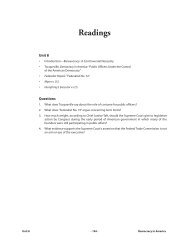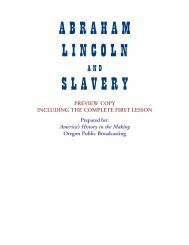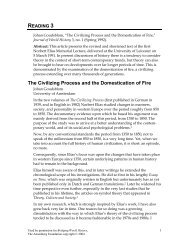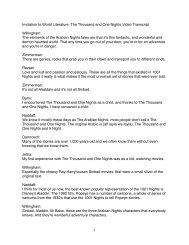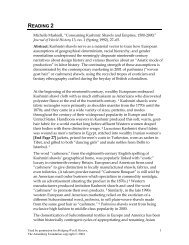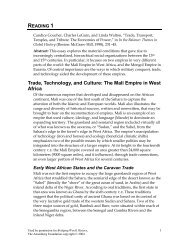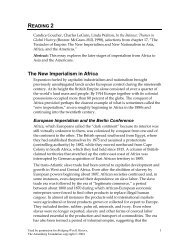UTOPIAN PROMISE - Annenberg Media
UTOPIAN PROMISE - Annenberg Media
UTOPIAN PROMISE - Annenberg Media
You also want an ePaper? Increase the reach of your titles
YUMPU automatically turns print PDFs into web optimized ePapers that Google loves.
[2793] The Quaker Meeting, courtesy<br />
of George Fox University. Quaker<br />
churches like this one are “plain-style”<br />
buildings defined by their linear design,<br />
exposed structural supports, and open<br />
lighting. These unpretentious interiors<br />
have no altars or pulpits, creating<br />
unadorned spaces that allow congregants<br />
to concentrate on their individual<br />
relationships with God. Illustration from<br />
Sydney George Fisher, The True William<br />
Penn (Philadelphia: J. B. Lippincott,<br />
1899).<br />
[2909] Thomas Fairland, George Fox<br />
(1914), courtesy of the Library of<br />
Congress [LC-USZ62-49456]. Facsimile<br />
of portrait drawn on stone. George Fox<br />
(1624–1691) founded the Society of<br />
Friends, or Quakers, based on the principle<br />
of the direct guidance of the Holy<br />
Spirit. In the portrait Fox wears what<br />
would become known as a “Quaker<br />
hat.”<br />
[6746] Nathaniel Delivan, Bill of Sale<br />
for Slaves, New York (1700), courtesy of<br />
the Library of Congress, Rare Books and<br />
Special Collections, Printed Ephemera.<br />
Early opponents of slavery like John<br />
Woolman addressed the institution’s<br />
existence in all of the British colonies.<br />
Hudson Valley wheat plantations used<br />
slaves, while merchants and ships from<br />
ports like Boston, New York, and<br />
Philadelphia brought slaves to those<br />
towns along with southern and<br />
Caribbean colonies.<br />
28 UNIT 3, <strong>UTOPIAN</strong> <strong>PROMISE</strong><br />
leaf Whittier, Henry David Thoreau, and Theodore Dreiser. Woolman’s<br />
commitment to social justice and his concern with issues that continue<br />
to haunt American culture—problems such as bigotry, violence, materialism,<br />
and poverty—have given his work a lasting relevance.<br />
TEACHING TIPS<br />
■ Woolman participates in a long tradition of Quaker journal-keeping<br />
begun by George Fox, the founder of the sect. Pious Quakers routinely<br />
composed spiritual autobiographies to be published after their<br />
deaths as examples and guides for those who read them. It seems clear,<br />
then, that Woolman carefully crafted and revised his Journal in anticipation<br />
of its eventual publication. Given this information, ask students<br />
to consider how Woolman’s sense of audience and literary conventions<br />
might have influenced the composition and shaped the meaning of the<br />
Journal.<br />
■ Woolman frequently explains his religious motivations in terms<br />
of “openings,” or “drawings” sent to him by God. Ask students what<br />
they think he means by these terms. What rhetorical purpose do they<br />
serve? How do they work to justify Woolman’s actions? Ask students<br />
to reflect on the potential problems this passive ideal of acting only<br />
when moved by God might pose for someone like Woolman. In explicating<br />
the tensions between activity and passivity in the Journal, you<br />
might point out Woolman’s consistent use of the passive voice in his<br />
description of religious experiences.<br />
QUESTIONS<br />
Comprehension: What rhetorical strategies and appeals does<br />
Woolman use to argue against slavery in Some Considerations on<br />
the Keeping of Negroes? Which are most persuasive? Which do you<br />
think would have been most effective in persuading other eighteenth-century<br />
Americans to abolish slavery?<br />
Context: Woolman’s Journal has been celebrated as a particularly<br />
beautiful and effective example of “plain style.” How does his use of<br />
this style compare to that of other plain stylists discussed in this<br />
unit (Bradford, Bradstreet, and Penn, for example)? What kinds of<br />
values and beliefs might Woolman’s style reflect? Are they the same<br />
or different from the values held by Puritan plain stylists?<br />
Exploration: How do Woolman’s concerns prefigure later social<br />
movements in America (abolitionism, civil rights issues, the development<br />
of welfare programs, for example)? Can you trace his influence<br />
in any contemporary discussions of social justice issues? What<br />
might Woolman think of contemporary American society? How<br />
would he feel about the ongoing problems of racism, bigotry, poverty,<br />
violence, and materialism?



